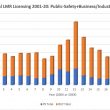FCC, LMCC reps discuss narrowbanding implementation
Frequency coordinators and the FCC enforcement bureau plan to work together to identify licensees that have not complied with the narrowbanding mandate, so that appropriate action can be taken, according to Mark Crosby, president/CEO of the Enterprise Wireless Alliance (EWA).
Representatives of the Land Mobile Communications Council (LMCC) — of which Crosby is secretary/treasurer — and the FCC discussed the situation earlier this week during an “informal” meeting, Crosby said. FCC officials indicated that a further public notice would be released at some point — possibly during the first quarter of this year — and that the FCC will conduct some sort of audit of spectrum licenses affected by narrowbanding.
With the FCC and frequency coordinators trying to process significant numbers of narrowbanding applications filed shortly before the Dec. 31, 2012, deadline, any licensees that have not completed the task are urged to do so as quickly as possible to minimize potential penalties, Crosby said.
“My sense is that the FCC wants time to accommodate the thousands of applications that came in late; I don’t know how many requests for waivers or requests are still there, but there is a significant number,” Crosby said during an interview with Urgent Communications. “With all the lists of call signs backlogged, I think — before they start launching efforts for those that are noncompliant — they want to get some stuff done, so they’ll have a better view of the landscape, which makes eminent sense.”
Crosby was especially encouraged by the notion of an audit, because he and other frequency coordinators believe many of the licensees that have not taken any action to narrowband their system do not actually have active systems on the spectrum currently. By identifying these situations with frequency coordinators making the initial contact with the licensee and the FCC enforcement bureau following up, those licenses can be canceled, allowing others to apply to use the airwaves, he said.
“I think there’s somewhat of an understanding that, of the [licensees that have not addressed narrowbanding], half of them are not there — at all,” Crosby said. “They’ve moved on to other things [spectrum bands or communications systems], and the license has never been cancelled. The benefit of just identifying that is huge — it’s like a spectrum allocation almost.”
FCC officials indicated during the meeting that frequency coordinators should protect noncompliant licensees as if they had complied with the narrowbanding mandate, reiterating the agency’s public notice issued on Nov. 30, Crosby said. Shortly after that public notice was released, the LMCC asked the FCC to reconsider its position on the matter and adopt the LMCC request that noncompliant licensee be treated as if their systems do not exist at all.
















AASHTO has been working with
AASHTO has been working with some dealers representing seasonal radio users. One dealer we are working with stated many of his clients aren’t using their system currently so the station is silent. Even though the station is licensed for wide emissions only, the license holder is compliant as the station is not transmitting. The dealer stated these licensees have no intention of converting their system and modifying their license until they are ready to begin operation later this year.
The fact that the frequency
The fact that the frequency coordinators suspect that many licenses are not active is significant. The FCC needs to recognize the realities that issuance of a land mobile license for a period of 10 years is part of the problem. Here in LA, in the VHF and UHF bands, I suspect upwards of 30% of the stations with licenses more than 5 years old are “inactive”.